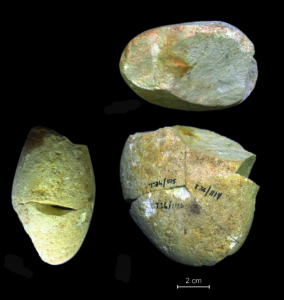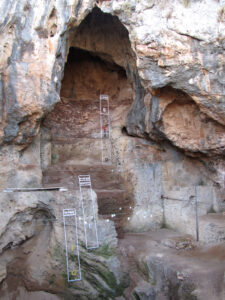Oldest Evidence of Abrading Stone Tool Technology by Our Hominin Ancestors 350,000 Years Ago. The abrading tool, found in Tabun Cave on Mount Carmel by researchers from the University of Haifa, predates previous findings by around 150,000 years.

A new study published in the prestigious Journal of Human Evolution by Dr. Ron Shimelmitz, Dr. Iris Groman-Yaroslavski, Prof. Mina Weinstein-Evron, and Prof. Danny Rosenberg of the Zinman Institute of Archaeology, identifies the oldest tool used for abrading various materials around 350,000 years ago, before the appearance of Homo sapiens. The tool, a rounded dolomite pebble bearing microscopic signs of abrasion, was found in Tabun Cave on Mount Carmel, one of the key prehistoric sites in Israel and around the world. The finding predates by around 150,000 all other tools found to date bearing signs of abrasion. The researchers note that “the unusual finding from Tabun Cave shows that hominins processed various materials by means of abrasion as early as 350,000 years ago. In other words, at a very early stage they added a crucial technology to their toolkit showing that they were both willing and able to process materials in various ways in order to maximize their exploitation of the resources they found around them.”
Tabun Cave, which forms part of the UNESCO Sites of Human Evolution at Mount Carmel: The Nahal Me’arot / Wadi el-Mughara Caves, is unique due to the series of approximately 100 superimposed archeological layers that have been exposed in it, testifying to the activities of hominins (types of humans, including types of ancient humans) over the past 500,000 years. For 90 years, the site has been an important focus for the study of human evolution. The extraordinary finding was uncovered as part of a new project led by Dr. Shimelmitz, together with Prof. Mina Weinstein-Evron, together with partners from Israel and abroad. The project is reexamining findings from previous excavations at the site [the project is supported by the Israel Science Foundation, the Gerda Henkel Foundation, and the Dan David Foundation). While analyzing findings uncovered in the excavations undertaken at the cave in the 1960s by Prof. Arthur Jelinek of the University of Arizona that have not previously been researched or published, Dr. Shimelmitz noticed that one of the stones showed clear signs of abrasion. These signs were similar to those found on much later stone tools, but had not been seen before on tools dating back hundreds of thousands of years.
A careful analysis of the item in the laboratories of the Zinman Institute of Archaeology provided a systemic profile of the signs of use wear on the surface of the stone. The research, undertaken together with Prof. Danny Rosenberg, Head of the Laboratory for the Study of Stone Tools and Ancient Food Processing Technologies, and Dr. Iris Groman-Yaroslavski Head of the Laboratory for Use-Wear Analysis, focused on a microscopic examination of the pebble.

In order to understand and interpret the patterns seen under the microscope, the researchers undertook a series of controlled abrasion experiments using natural dolomite pebbles collected on Mount Carmel that have similar characteristics to the pebble found in Tabun Cave. During the experiment, various materials were abraded over different periods of time using the pebbles, which were immediately subjected to microscopic examination to identify the abrasion patterns created in the experiments. “Although the results did not show a full correlation between the patterns of abrasion seen on the unique pebble and those we documented in our experiments, we found a high level of similarity to the abrasion marks found following the abrasion of animal skins. Accordingly, we concluded that the ancient stone-tool was used for the abrading of soft materials, although we still do not know exactly which,” Dr. Groman-Yaroslavski explained.
“Although this tool is ostensibly ‘simple,’ its appearance at such an early date and the fact that it is unparalleled in findings from this early stage of human evolution mean that it is of global importance,” the researchers note. They explain that the early appearance of abrasion technology underscores the depth and complexity of the chain of technological innovations associated with human evolution. When did hominins begin to abrade food and other materials? Where did this take place? And why? These are just some of the questions of interest to researchers iof human evolution.
“In essence, the evolution of technology manifested in the stone tools is a direct reflection of the patterns of change in the ability of ancient hominins to shape their environment,” Dr. Shimelmitz explains. “The period of time 400,000 – 200,000 years ago was one of important technological innovations and significant changes in human behavior. For example, the use of fire becomes part of the daily routine, as well as the use of base camps from which the hominins went out for various activities. Thus the abrasion technology does not appear in isolation, but as part of a network of broader changes that, to an extent anticipates the more complex behavior with which we are familiar from later hominins such as Neanderthals and Homo sapiens.”
As mentioned above, the next evidence of the use of abrading comes only after some 150,000 years. Was this capability “lost” and then “found” after such a long interval? “Although we were not able to associate this item with certainty to food processing, it is highly probable that it was used for this purpose. Whatever the case, for those of us who are involved in the archeology of food and of food-processing methods in different periods – from prehistory to modern times – this little pebble from Tabun is of enormous importance. It allows us to explore the earliest origins of the act of abrasion and to see how cognitive and motor capabilities that developed over the course of human evolution ultimately led to phenomena that continue to be important in modern human culture. These processes had their beginnings in abrasion and in the development of food processing techniques, and extended to such realms as the transition to permanent settlements, agriculture, storage, and the rise in social and economic complexity,” Prof. Rosenberg concludes.
14.1.21



